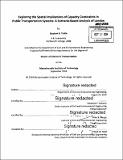| dc.contributor.advisor | Frederick P. Salvucci and Mikel E. Murga. | en_US |
| dc.contributor.author | Tuttle, Stephen B. (Stephen Bradford) | en_US |
| dc.contributor.other | Massachusetts Institute of Technology. Department of Civil and Environmental Engineering. | en_US |
| dc.coverage.spatial | e-uk-en | en_US |
| dc.date.accessioned | 2015-02-25T17:11:05Z | |
| dc.date.available | 2015-02-25T17:11:05Z | |
| dc.date.copyright | 2014 | en_US |
| dc.date.issued | 2014 | en_US |
| dc.identifier.uri | http://hdl.handle.net/1721.1/95574 | |
| dc.description | Thesis: S.M. in Transportation, Massachusetts Institute of Technology, Department of Civil and Environmental Engineering, 2014. | en_US |
| dc.description | Cataloged from PDF version of thesis. | en_US |
| dc.description | Includes bibliographical references (pages 151-154). | en_US |
| dc.description.abstract | In growing regions with large public transportation systems, the distribution of available capacity can affect where development occurs and determine which users and land uses suffer from further crowding. However, analyzing the spatial relationship between available capacity and economic impacts may not be straightforward, and common modeling practice can bias results. Improved modeling practice that more realistically includes capacity and crowding effects has the potential to better predict the benefits of new transportation investments and land use densification strategies. A series of conventional and innovative techniques, based on static assignment, is applied in three planning scenarios to explore the spatial distribution of disbenefits from crowding in London's public transportation system. The featured scenario examines the crowding relief on existing commuter lines from the opening of a parallel high-speed rail (HSR) line. A sketch assignment model is developed in TransCAD to demonstrate the potential of common modeling practice to bias travel cost estimates, thereby distorting economic predictions. Conventional methods for enforcing capacity constraint, such as controlling vehicle loading through a link-based penalty, are shown to bias predictions of which users and land uses suffer from crowding. Second, the organized application of select link analysis is found to contribute to a better understanding of which transportation investments and land uses exacerbate crowding problems and which transportation facilities and land uses are vulnerable to crowding problems. Finally, the proposed high-speed rail line is found to reduce crowding on existing commuter lines, thereby improving the development potential of adjacent land uses. This research aims to highlight certain aspects of the spatial relationship between capacity constraints and economic impacts in large public transportation systems. However, further model refinements, sensitivity tests, and empirical validation are needed to substantiate the initial findings. This research explores only a subset of the potential service challenges from crowding. An enhanced static assignment model or dynamic assignment model could be applied to model these omitted service challenges and develop more robust conclusions. | en_US |
| dc.description.statementofresponsibility | by Stephen B. Tuttle. | en_US |
| dc.format.extent | 163 pages | en_US |
| dc.language.iso | eng | en_US |
| dc.publisher | Massachusetts Institute of Technology | en_US |
| dc.rights | M.I.T. theses are protected by copyright. They may be viewed from this source for any purpose, but reproduction or distribution in any format is prohibited without written permission. See provided URL for inquiries about permission. | en_US |
| dc.rights.uri | http://dspace.mit.edu/handle/1721.1/7582 | en_US |
| dc.subject | Civil and Environmental Engineering. | en_US |
| dc.title | Exploring the spatial implications of capacity constraints in public transportation systems : a scenario-based analysis of London | en_US |
| dc.type | Thesis | en_US |
| dc.description.degree | S.M. in Transportation | en_US |
| dc.contributor.department | Massachusetts Institute of Technology. Department of Civil and Environmental Engineering | |
| dc.identifier.oclc | 903592608 | en_US |
